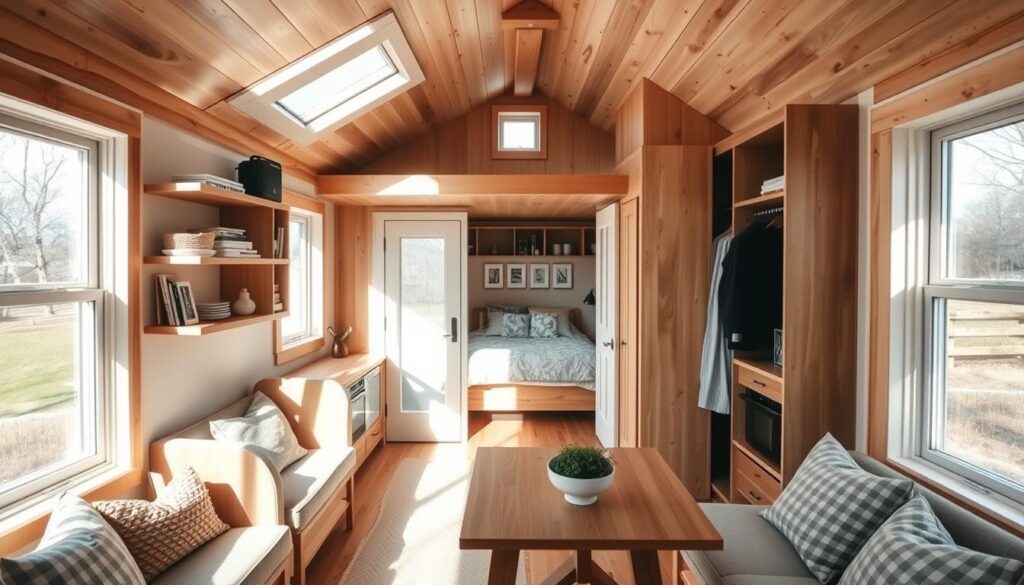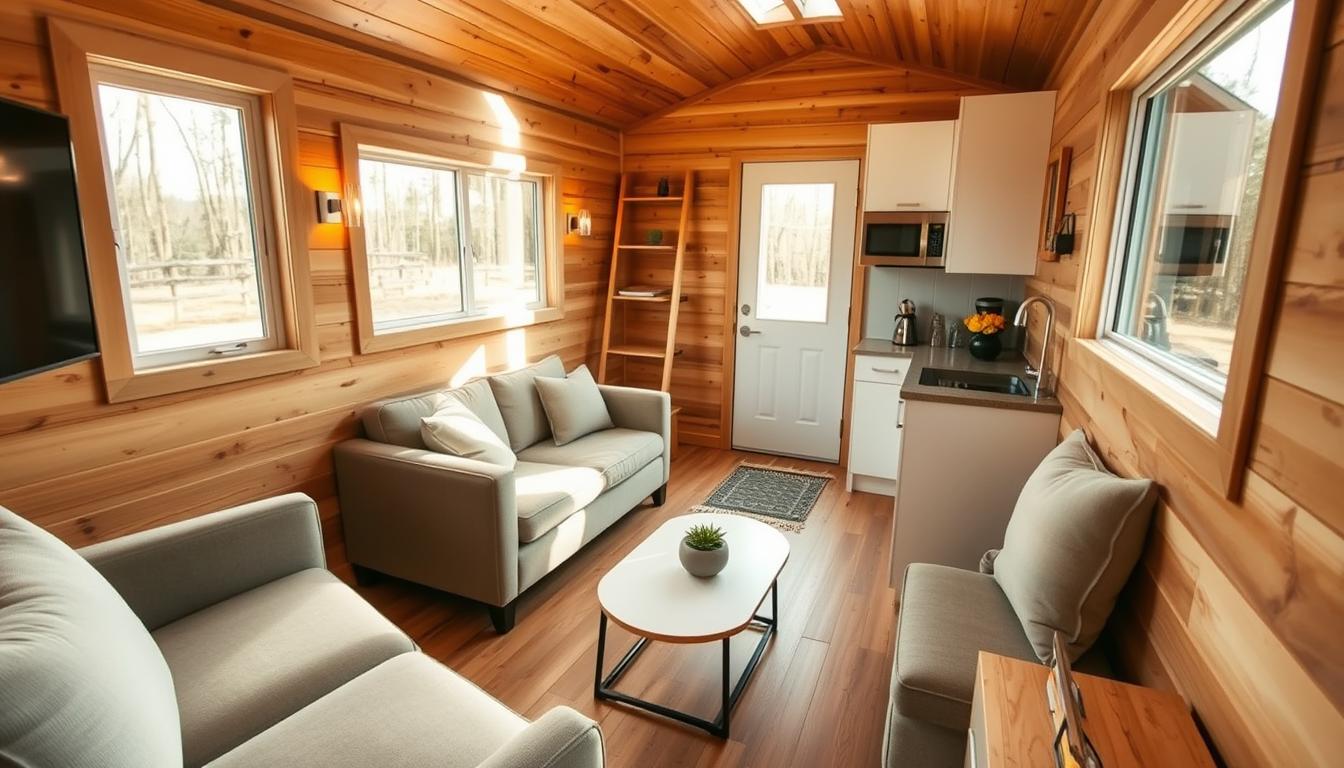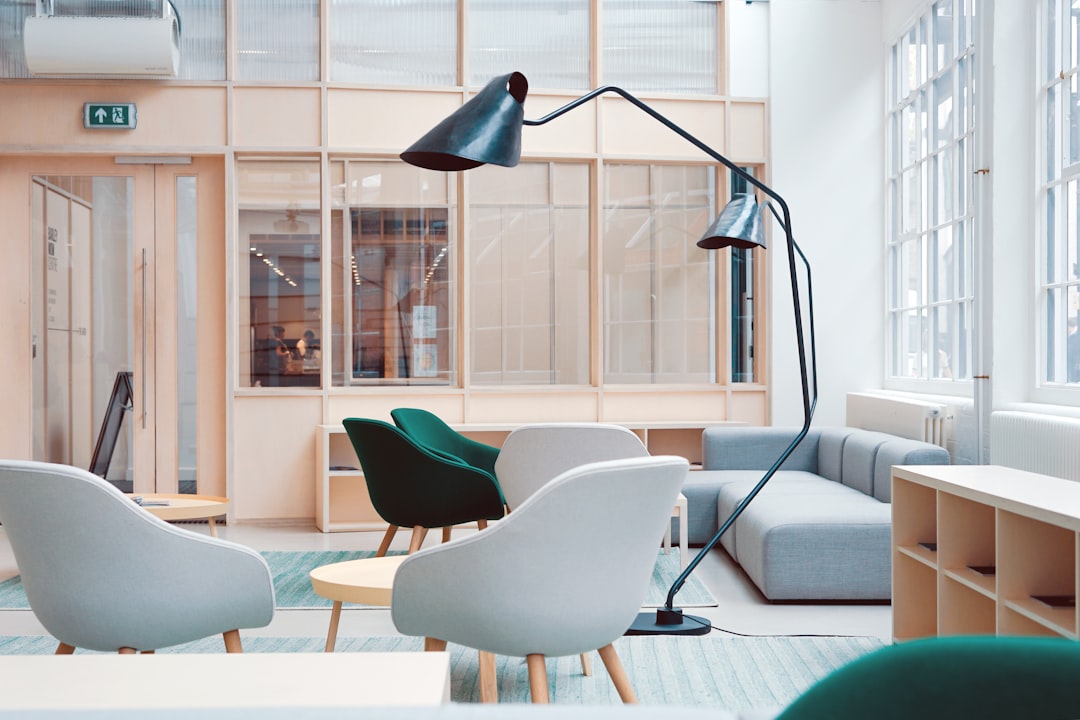Did you know over 10,000 people in the U.S. live in small spaces? They’re choosing a minimalist lifestyle. This trend has made tiny house interior design very popular. We’re excited to share our best tips for making a tiny home both functional and beautiful.
Designing a tiny home means thinking about every detail. You need good storage and furniture that does more than one thing. By understanding the challenges and benefits of small spaces, you can make a stylish and useful home.
Key Takeaways
- Optimize your space with multi-functional furniture
- Utilize vertical storage to maximize space
- Select a color palette that enhances the sense of space
- Invest in smart lighting solutions
- Personalize your space with thoughtful decor
Understanding Tiny House Living
To thrive in a tiny house, you need to grasp the basics of compact design and minimalist living. This lifestyle is more than just small spaces. It’s about living with purpose.
Living in a tiny house means valuing simplicity and sustainability. It’s about making a home that’s both functional and beautiful.
The Benefits of Downsizing
Downsizing to a tiny house offers many perks. You’ll save money and reduce your environmental impact. By owning fewer things, you focus on what truly matters.
- Reduced financial burden
- Less environmental impact
- Simplified living
Embracing Minimalism
Minimalism is key to tiny house living. It helps create a tidy, efficient space that brings calmness.
To achieve a minimalist look, consider these tips:
| Principle | Description | Benefit |
|---|---|---|
| Simplify | Reduce clutter and unnecessary items | Less stress, more focus |
| Neutralize | Use a neutral color palette | Creates a sense of calm |
| Optimize | Make the most of available space | Increased functionality |
Key Considerations for Space
Designing a tiny house requires careful thought about space. Think about how people move through the space and how to store things efficiently.
By focusing on these aspects, you can build a tiny house that’s both lovely and practical. As we explore tiny house living, it’s clear that smart design is crucial.
Planning Your Layout Efficiently
A well-planned layout is key to a cozy tiny home. When designing, think about how to use space wisely.
Open-Concept vs. Defined Spaces
First, decide between an open-concept or defined spaces. Open-concept living makes your home feel bigger by removing walls. But, defined spaces offer privacy and function.
A separate bedroom is great for quiet time. Yet, an open layout can make your home feel larger and flow better. Choose what fits your life best.
Zoning for Functionality
It doesn’t matter if you pick open-concept or defined spaces. Zoning for functionality is crucial. Divide your home into zones for different activities, like cooking or relaxing.
Use furniture and decor smartly to zone areas. A well-chosen tiny home furniture piece can mark a zone without walls. For more tips, see 5 tips to consider when designing a tiny home.
Flow and Navigation
Flow and navigation are as important as layout. A clear path makes your home feel bigger and more welcoming. Look into compact design solutions to improve movement.
“A well-designed tiny home should feel like a harmonious blend of functionality and comfort.”
To ensure good flow, don’t block paths with too much stuff. Choose multi-functional items to cut down on clutter and make moving around easier.
Choosing the Right Color Palette
Choosing the right colors for your tiny house is more than looks. It’s about making your space feel bigger. The colors you pick can change how your tiny home feels. By using minimalist decor and sustainable design practices, you can make a cozy and useful living area.
Light Colors to Enhance Space
Light colors make spaces look bigger and more open. Soft whites, creams, and pale grays reflect light well. This makes your tiny house feel airy. For more color ideas, check out our guide on color scheme ideas for home interiors.
Bold Accents for Character
Light colors make space feel bigger, but bold accents add personality. Use bright colors in furniture, artwork, or decor for interest. Here are some ways to add bold touches:
- Use brightly colored throw pillows and blankets
- Choose statement furniture pieces
- Add colorful artwork or prints
The Psychological Impact of Colors
Colors deeply affect our mood and well-being. Blues and greens calm us, while yellows and oranges energize. Pick colors that make you feel good in your tiny home.
Think about:
- The natural light in your space
- The color of your furniture and fixtures
- The look you want to achieve
Multipurpose Furniture Solutions
Multipurpose furniture is a big help for tiny home living. It’s functional and stylish. Every piece of furniture should do more than one thing to save space and be efficient.
Bed Frames with Storage Options
Bed frames are key in any home. In tiny homes, ones with storage are especially useful. They might have drawers or storage under the mattress.
For example, a bed with drawers can hold clothes and personal items. This keeps them out of the way but still easy to reach.
Some popular designs include:
- Platform beds with built-in drawers
- Storage beds with hydraulic lifts for easy access to under-bed storage
- Murphy beds that fold up against the wall, revealing storage compartments or other functional areas
Convertible Sofas and Dining Sets
Convertible sofas and dining sets are great for tiny homes. They can change to meet different needs. This makes them perfect for small spaces.
A sofa can be a comfy seat by day and a guest bed at night. A dining table can be a workspace by day and a place to eat in the evening.
Choosing Built-In Features
When picking built-in features, think about your lifestyle. Consider what you do often and how furniture can help. For example, a desk that’s also a dining table is great for working from home.
Some things to keep in mind include:
- Think about your daily routines and how furniture can make things more efficient
- Measure your space to make sure furniture fits well and works as planned
- Look at different designs and materials to find what fits your style and budget
By using multipurpose furniture, you can make your tiny home functional, comfy, and stylish. It will meet your unique needs perfectly.
Maximizing Vertical Space
One key strategy for tiny house interiors is to use vertical space well. This makes the living area feel bigger and more functional. We’ll look at ways to use your vertical space effectively.
Utilizing Wall Shelves
Wall shelves are great for adding storage without using floor space. They can hold decorative items, books, or kitchen tools. Choose shelves that match your home’s style.
- Floating shelves for a minimalist look
- Decorative brackets for added style
- Adjustable shelves for versatility
Hanging Storage Ideas
Hanging storage keeps things organized and out of the way. Options like hanging baskets and over-the-door racks are useful. They work well in kitchens and bathrooms.
- Hanging baskets for storing linens or toys
- Over-the-door shoe organizers for maximizing closet space
- Hanging rod dividers for keeping clothing organized
Tall Furniture Solutions
Tall furniture, like storage units and bookshelves, makes rooms feel taller. Choose furniture that fits well in your tiny home.
Key considerations:
- Proportionate scale to the room
- Multi-functional designs for added utility
- Material and finish that complement the existing decor
Using these strategies can make your tiny home more livable and comfortable. Whether you have a compact design or want to improve your small space, these tips will help.
Smart Storage Solutions
In tiny houses, smart storage is key to keeping things tidy and organized. It’s not just about hiding clutter. It’s about making your space more livable and sustainable.
Under-Bed Storage Ideas
Using under-bed storage is a smart way to save space. You can get bed frames with drawers or bins that slide under the bed. Under-bed storage is great for seasonal clothes, linens, or luggage.
For example, under-bed containers can keep your bedroom neat. It’s also eco-friendly to use old containers or crates for storage.
Utilizing Hidden Compartments
Hidden compartments add security to your tiny home. You can find secret drawers in furniture or hidden storage behind wall art. There are many creative ways to add hidden spaces to your design.
Hidden compartments not only add security but also help keep things tidy. For instance, a hidden spot in a coffee table can store important documents or small valuables.
Creative Closet Solutions
Closet organization is vital in tiny houses. You can use double rods, shelving, and bins to make the most of vertical space. Optimizing your closet reduces clutter and improves your home’s function.

| Storage Solution | Description | Benefits |
|---|---|---|
| Under-Bed Storage | Storage bins or drawers under the bed | Space-saving, keeps clutter out of the way |
| Hidden Compartments | Secret drawers or hidden storage | Enhances security, reduces clutter |
| Creative Closet Solutions | Double rods, shelving, and bins | Maximizes space, improves organization |
By using these smart storage ideas, your tiny house can be more organized and clutter-free. It will follow the principles of tiny house interior design and sustainable design practices.
Personalizing Your Tiny Home
Making your tiny home your own is a mix of creativity and practicality. It’s all about making a small space feel warm and inviting. We’ll look at ways to do this, like showing off your art and adding plants.
Displaying Artwork and Decor
Art and decor can really make your tiny home stand out. Pick pieces that show off your style to make it feel more like home. Opt for minimalist decor that adds character without cluttering.
It’s key to find a balance in small spaces. Choose a few standout pieces or create a gallery wall. This adds interest without feeling too crowded.
Tailoring to Your Lifestyle
It’s important to make your tiny home fit your lifestyle. Think about your daily routines and hobbies when designing. For example, if you work from home, a dedicated workspace is a must.
If you love to cook, get compact, multi-use kitchen appliances. This makes cooking in your tiny home a breeze. It shows how your home supports your small space living needs.
Incorporating Greenery
Adding plants to your tiny home can really improve its feel. Plants clean the air and bring nature indoors. Choose easy-to-care-for plants like succulents or air plants for small spaces.
Use hanging plants or vertical planters to add greenery without taking up floor space. This not only makes your home look better but also makes it healthier.
Sustainable Design Practices
Sustainable living is key in the tiny house movement. It begins with the design we choose. We can greatly reduce our environmental impact by designing our tiny homes wisely.
Using eco-friendly materials is a big part of sustainable design. Eco-friendly materials are sustainable, recyclable, and have a low environmental impact. Examples include reclaimed wood, bamboo, and paints with low VOCs.
Eco-Friendly Materials
When picking materials for our tiny homes, we should think about their environmental impact. Here’s a look at some common materials:
| Material | Sustainability | Cost |
|---|---|---|
| Reclaimed Wood | High | Moderate to High |
| Bamboo | High | Moderate |
| Low-VOC Paints | High | Moderate |
| Traditional Hardwood | Low to Moderate | High |
Choosing eco-friendly materials is good for the environment and can save money in the long run.
Energy-Efficient Appliances
Using energy-efficient appliances is also crucial. These appliances use less energy, cutting down our carbon footprint and saving on utility bills.
“Energy efficiency is not just about saving energy; it’s about creating a better future for our planet.” –
Examples of energy-efficient appliances include LED lights, energy-star rated refrigerators, and induction cooktops.
Waste Reduction Techniques
Reducing waste is vital in sustainable living. In tiny homes, we can do this through careful planning and design. We can minimize packaging, repurpose materials, and design for minimalism.
By using these sustainable design practices, we can make tiny homes that are beautiful, functional, and good for the environment.
Creating an Inviting Atmosphere
As we finish our tiny house interior design, making it inviting is key. We want our small space to feel cozy and welcoming. To do this, we focus on elements that improve the feel of our tiny home.
Effective Lighting
Lighting is crucial in small spaces. We mix overhead lights, table lamps, and string lights. This creates a warm, inviting feel, making our space seem bigger.
Comfort through Textiles
Textiles and comfort are essential for coziness. We add plush rugs, throw blankets, and soft cushions. These not only warm our space but also add texture.
Aromatherapy’s Role
Aromatherapy is important for a relaxing atmosphere. Essential oils help make our tiny house feel calm. With our design and aromatherapy, our space becomes truly inviting.



